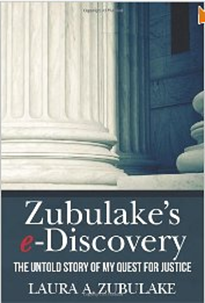Last week, we discussed the new book by Laura A. Zubulake, the plaintiff in probably most famous eDiscovery case ever (Zubulake vs. UBS Warburg), entitled Zubulake's e-Discovery: The Untold Story of my Quest for Justice. I also conducted an interview with Laura last week to get her perspective on the book, including her reasons for writing the book seven years after the case ended and what she expects readers to learn from her story.
The book is the story of the Zubulake case – which resulted in one of the largest jury awards in the US for a single plaintiff in an employment discrimination case – as told by the author, in her words. As Zubulake notes in the Preface, the book “is written from the plaintiff’s perspective – my perspective. I am a businessperson, not an attorney. The version of events and opinions expressed are portrayed by me from facts and circumstances as I perceived them.” It’s a “classic David versus Goliath story” describing her multi-year struggle against her former employer – a multi-national financial giant. The book is available at Amazon and also at CreateSpace.
Our interview with Laura had so much good information in it, we couldn’t fit it all into a single post. Yesterday was part 1. Here is the second and final part!
What advice would have for plaintiffs who face a similar situation to the one you faced?
I don’t give advice, and I’ll tell you why. It’s because every case is different. And, it’s not just the facts of the case but it’s also the personal lives of the plaintiffs. So, it’s very difficult for me to do that. Unless you’re in someone else’s shoes, you really can’t appreciate what they’re going through, so I don’t give advice.
What do you think about the state of eDiscovery today and where do you think that more attention could be paid to the discovery process?
While I don’t work in the industry day-to-day, I read a lot and keep up with the trends and it’s pretty incredible to me how it has changed over the past eight to nine years. The first opinions in my case were in 2003 and 2004. Back then, we had so little available with regard to technology and legal guidance. When I attend a conference like LegalTech, I’m always amazed at the number of vendors and all the technology that’s now offered. From that standpoint, how it has matured as an industry is a good thing. However, I do believe that there are still important issues with regard to eDiscovery to be addressed. When you read surveys and you see how many corporations still have yet to adopt certain aspects of the eDiscovery process, the fact that’s the case raises concern. Some firms have not implemented litigation holds or document retention policies or an information governance structure to manage their information and you would think by now that a majority of corporations would have adopted something along those lines.
I guess organizations still think discovery issues and sanctions won’t happen to them. And, while I recognize the difficulty in a large organization with lots of employees to control everything and everybody, I’m surprised at the number of cases where sanctions occur. I do read some of the case law and I do “scratch my head” from time to time. So, I think there are still issues.
Obviously, the hot topic now is predictive coding. My concern is that people perceive that as the “end all” and the ultimate answer to questions. I think that processes like predictive coding will certainly help, but I think there’s still something to be said for the “human touch” when it comes to reviewing documents. I think that we’re making progress, but I think there is still more yet to go.
I read in an article that you were considering opening up an eDiscovery consulting practice. Is that the case and, if so, what will be unique about your practice?
It’s something that I’m considering. I’ve been working on the book, but I’d like to get back into more of a routine and perhaps focus on education for employees. When people address eDiscovery issues, they look to implement technology and look to establish retention policies and procedures to implement holds, and that’s all good. But, at the same time, I think there should be more efforts to educate the employees because they’re the ones who create the electronic documents. Educate them as to the risks involved and procedures to follow to minimize those risks, such as litigation holds. I think if you have an educated workforce and they understand that “less is more” when writing electronic documents, that they don’t always have to copy someone or forward something, that they can be more selective in their writing to reduce costs.
I think because of my background and my personal experiences and because I’m not an attorney, I can relate more to the typical worker. I was on the trading desk and I know the day-to-day stresses of trying to manage email, trying to do the right thing, but also trying to be productive. I think I can also relate to senior management and advise them that, although they may not recognize the risk, the risk is there. And, that’s because I’ve been a worker, I’ve been on the trading desk, I’ve been through litigation, I’ve actually reviewed documents and I’ve gone to trial. So, if you think that not implementing information governance or other eDiscovery policies is a good idea, that’s not the case. Corporations should see this as an opportunity to manage information and use those management structures for the benefit of their company.
Thanks, Laura, for participating in the interview!
And to the readers, as always, please share any comments you might have or if you’d like to know more about a particular topic!
Disclaimer: The views represented herein are exclusively the views of the author, and do not necessarily represent the views held by CloudNine Discovery. eDiscoveryDaily is made available by CloudNine Discovery solely for educational purposes to provide general information about general eDiscovery principles and not to provide specific legal advice applicable to any particular circumstance. eDiscoveryDaily should not be used as a substitute for competent legal advice from a lawyer you have retained and who has agreed to represent you.





